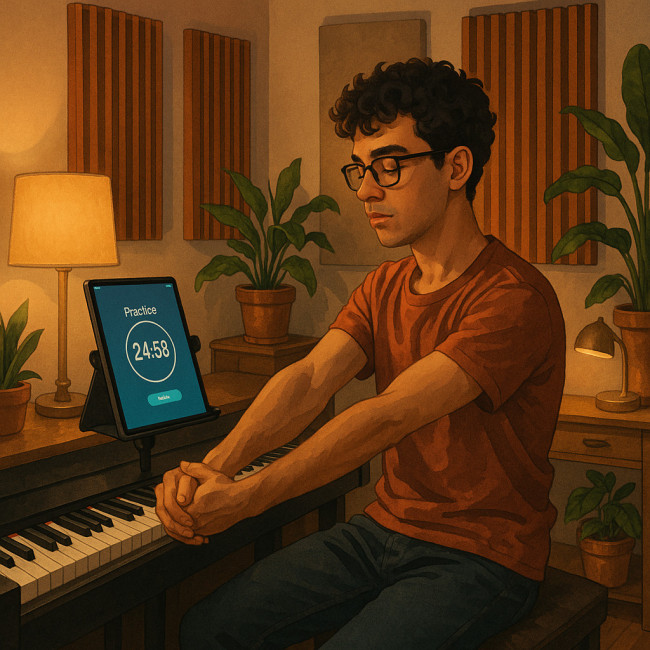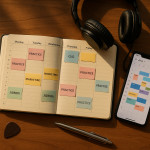Daily practice frameworks that boost technique while preventing wrist pain
Want to refine your playing and arrive at each gig pain-free? Discover science-backed daily practice frameworks that boost technique while preventing wrist pain, with step-by-step routines, ergonomic tweaks and scheduling tricks you can apply tonight.
Why wrist pain strikes even seasoned musicians

More than 40 % of instrumentalists report recurrent wrist discomfort. Repetitive motions, poor posture and frantic last-minute rehearsals overload tendons and nerves. When ignored, inflammation can derail tours, studio work and income. Prolonged nerve compression causes loss of fine-motor control, pins-and-needles sensations, and even irreversible carpal-tunnel damage if years of gigging pass without intervention. Understanding the biological chain reaction—microscopic tears, oedema, scar-tissue build-up—explains why smart players adopt preventive frameworks before the first twinge becomes a career-threatening obstacle.
The 3-pillar framework for healthy, high-impact practice
1. Ergonomic micro-setups
- Neutral wrist angle: Position keyboards or fretboards so your forearm lines up with hand height. A folding laptop stand can raise a MIDI controller by 12 cm and cut wrist extension by 18 °.
- Supportive seating: Choose a chair that keeps hips slightly above knees; this prevents slouching that forces wrists to compensate.
- Smart accessories: Light-tension strings, low-profile key action or an ergonomic mouse guard against overexertion between takes.
2. Time-boxed technique drills
Adopt 25-minute “focus blocks” followed by 5-minute resets. Research shows muscle fatigue spikes after the 30-minute mark; strategic pauses let tissues recover while memory consolidates. Pair each block with a single goal:
- Warm-up mobility (5 min): wrist circles, finger flicks, gentle forearm stretches.
- Velocity bursts (10 min): metronome scales at 60 % max speed, adding 5 BPM per block.
- Repertoire refinement (10 min): loop 4-bar phrases, analysing articulation or tone.
3. Recovery and load tracking
Log perceived exertion (1–10) and any twinges after each block. If soreness exceeds 4/10, reduce the next day's volume by 20 %. Apps such as time-blocking planners popular among musicians visualise patterns and highlight overuse before injury sets in.
Sample day plan for guitarists
| Time | Activity | Goal | Wrist-safe tip |
|---|---|---|---|
| 08:00 | Dynamic stretch + foam roll (10 min) | Boost blood flow | Keep elbows at heart level |
| 09:00 | Focus block 1 | Alternate-picking speed | Use a 1 mm pick to lessen grip force |
| 11:00 | Focus block 2 | Chord-shape clarity | Rest thumbs on low E between reps |
| 13:00 | Walk + lunch | Nervous-system reset | Swing arms naturally |
| 15:00 | Focus block 3 | Song transitions | Adjust strap so wrist stays neutral |
| 20:00 | Low-intensity jam (20 min) | Creativity | Use lighter gauge strings |
Gear tweaks that multiply results
Avoid chasing speed with brute force. Upgrading equipment often yields faster gains and helps prevent wrist pain.
- Split keyboards: A slight negative tilt (front edge higher) reduces extension.
- Adjustable drum thrones: Raise by 3–4 cm to keep snare strikes below elbow height.
- Low-tension practice pads: Ideal for rudiments without shock loading.
- High-quality audio interface: Pairing practice with recording, like the tips in our self-recording gear guide, reveals micro-tension when listening back.
Preventing wrist pain on high-pressure days
Prioritise mobility breaks
During marathon sessions, schedule 3-minute resets every hour. Stand, shake hands loosely and perform prayer stretches. Even backstage, these micro-pauses preserve nerve glide.
Heat before, ice after
Apply a warm pack 15 minutes pre-practice to increase elasticity, then ice for 10 minutes post-session to curb inflammation.
Nutrition nudges
Magnesium-rich snacks (almonds, spinach) and omega-3 sources support tendon health. Keep a 750 ml water bottle in sight; dehydration thickens synovial fluid, amplifying friction.
Integrating digital learning without overload

Apps can extend chops but screen time can stall blood flow. Follow a 2-screen-1-play rule: for every two minutes analysing an exercise video, spend one minute physically applying it. Curated playlists on structured musician training hubs reduce doom-scroll rabbit holes. By pairing smart notifications with standing-desk alerts, you keep wrists moving, eyes refocusing and dopamine levels steady; the result is sharper focus without the creeping stiffness that long scrolling sessions create. Set brightness to match ambient light and place the tablet at eye level so neck alignment stays neutral; small ergonomic tweaks amplify joint health during digital learning marathons.
Game-changing warm-up sequence (5 minutes)
- Wrist wave: Palms down, ripple fingers toward forearm, 10 reps.
- Reverse prayer hold: Palms together behind back, 20 seconds.
- Tendon glide: Make hook, fist, straight, fan positions; 5 cycles.
- Finger taps: Thumb to each fingertip, eyes closed, 2 rounds.
- Grip relax: Squeeze soft ball 50 %, hold 3 s, release fully, 8 reps.
FAQ
- How long before results appear?
- Most players feel smoother runs and less stiffness within two weeks of consistent daily practice frameworks that boost technique while preventing wrist pain.
- Is 25 minutes the only effective block length?
- No. Advanced users might adopt 45/10 cycles, but any routine must include scheduled recovery to prevent wrist pain.
- Do wrist braces help during practice?
- Only if prescribed by a clinician. Braces can limit dexterity and mask warning signs.
- Can beginners follow the same frameworks?
- Absolutely. Start with half the volume and lighter resistance gear to solidify form.
- When should I consult a professional?
- If tingling persists beyond 48 hours or pain disrupts sleep, seek a physio or hand specialist.
Mini-quiz: Are your habits wrist-friendly?
Next steps: lock in momentum
Commit to a 14-day experiment: use the warm-up, three focus blocks and exertion log daily. Compare recordings from day 1 and day 14—most musicians note crisper articulation and zero wrist flare-ups.
Ready to elevate your craft? Download our printable checklist and keep it on your music stand. Protect your wrists, master your instrument and show up strong for every session.
P.S. Share your progress and tag us—community accountability doubles success rates!











